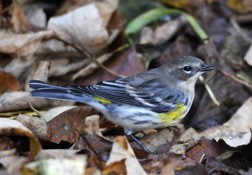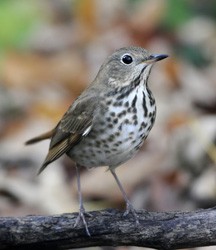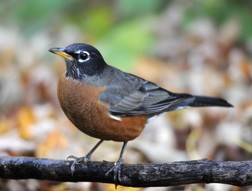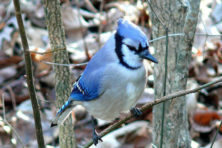Lingering Migratory Songbirds
- Share
- Tweet
- Pin
- Share

Yellow-rumped Warblers are very late migrants. A few may spend the early winter months here. Photo by Roy Lukes.
This day, Oct. 11, is one to remember. It’s 72 degrees F outside, sunny, and colorful leaves are falling, Wood Wasps are buzzing in all directions and a Monarch Butterfly is feasting on nectar at one of the tall zinnias near our house. Add to that nine species of birds at the feeders and especially the dripping water bath and it can’t get much better than that.
Yesterday, on an equally spectacular day, I spent three hours in the afternoon sitting in my portable bird blind photographing the birds at or near the water bath. The Cardinal, Mourning Dove, Black-capped Chickadee and Blue Jay were the only regulars that will stay on throughout the winter. The others are resting and feeding as they head south to their wintering grounds, species including the Hermit Thrush, White-crowned and White-throated Sparrows, Yellow-rumped Warbler, and American Robin. The Dark-eyed Juncos are here from the north and they most likely will remain for the duration of the cold months before heading back north.
The two warblers which usually are the last of their kind to be seen here before the end of the year are the Palm and the Yellow-rumped, with the latter being here the latest. We’ve had a few Yellow-rumps on past Christmas Bird Counts. We were living in the Rangelight Residence at the Ridges Sanctuary during the 1978 count, and I was lucky to get some good black and white photos of the little warbler as it ate tiny bits of beef suet at the feeder near our kitchen window.

This adult White-throated Sparrow may have nested in Door County and might linger into late December. Photo by Roy Lukes.
The Yellow-rumped Warbler is a Door County nester in limited numbers, and early this past October many dozens were observed at Weborg Point, the warbler “hotspot” in Peninsula State Park. They are strongly attracted to the dripping water bath in our front yard and both adults and young of the year spend much of the day darting among the small plants and shrubs in our woody front yard catching insects. Interestingly, as the weather turns colder their diet will change to include mainly wild berries.
One of my top favorite birds that nested at the Ridges when I worked there was the White-throated Sparrow. They favor spruce bogs from where their clear whistled songs easily reach the nearby hiking trails. A few are bound to be seen at well-stocked winter feeders near good cover and roosting sites. One can easily hear the sounds of these brown and white foragers scratching among the fallen leaves for seeds and insects. I scatter a handful of millet seeds every morning near the edge of the small grove of White Cedar trees into which they can quickly fly for cover. Remember that these birds have either a black and white striped crown or a dark brown and tan striped crown, along with a white throat. One cannot distinguish the sex of these birds by the crown color.
The flashy White-crowned Sparrows do not nest in the county and are usually seen in greatest number during their fall migration south, often lingering until late October. Adult males and females have the vivid black and white-striped crowns while the young of the year will sport tan and brown-striped crowns. Both immature and adult birds have easily-recognized pink bills, legs and feet. Bills on the White-throated Sparrows are dark. A few White-crowns will linger into winter at feeding stations.

Hermit Thrushes, with their long legs and rust-colored tails, nest sparingly in Door County. Photo by Roy Lukes.
A bird that has become a great favorite of ours is the shy and secretive Hermit Thrush. How fortunate we’ve been to have a pair of them nesting in our lower woods for the past several consecutive summers. Often at dawn or dusk the pair would come to drink and bathe at our water bath, always choosing the metal garbage can lid on the ground. Even I with my bad hearing could sit on our deck, facing their nesting site below the hill and hear the male’s exquisite song. Our friend, Sam Robbins, writing in his great book, Wisconsin Birdlife, described the song as the “prima donna of the ornithological chorus.”
There is an easily accessed place at the Whitefish Dunes State Park where their songs can be heard during the nesting season in late May and well into June. It’s along the Clark Lake Spur Trail that leads you to the shore of Clark Lake where one often hears these fantastic singers, especially to the south of the hiking trail. You’ll be richly rewarded not only by the “Hermit’s Serenade,” but also by the gorgeous large trees, including the largest Red Maple in Door County along with a host of interesting small plants. This is a gem of a trail.
The lone male American Robin that I photographed from my blind on the 11th was very wary as it eyed me suspiciously from the horizontal perch next to the bath. Immediately after I fired off a half dozen quick shots it left, without drinking or bathing. Its bold black head indicated that the bird was a male, and what surprised me was its intense dark orange-red breast and large white eye-ring.

American Robins, such as this male, may be seen here during every month of the year, but only sporadically in winter. Photo by Roy Lukes.
My bold guess is that this may be a northern race of Robin, the kind that will very likely spend the winter much farther north than those Robins that nested in Door County. Should there be a good supply of natural wild fruits, there’s a good chance that this bird may winter here.
Bear in mind that one doesn’t see the first Robin of spring in January or February. These birds have wintered here. Our state bird the Robin, is one of the five most numerous species present here in summer. Others are the Red-winged Blackbird, European Starling, House Sparrow and Common Grackle. The resident nesting Robins of Wisconsin have usually left for the South by mid-October. Those seen after this date are the wintering stragglers from farther to the north.
Enjoy the lingering songbirds while they’re here. And you “Snowbirds,” enjoy them both here and when you reach your wintering roosts!


